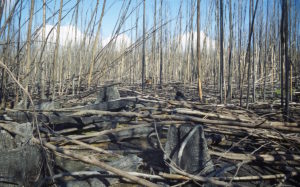Logging can make native forests more flammable and lead to greater fire severity for decades, while ‘mechanical thinning’ can also increase fire risk.

Burnt logging regrowth forest in the Victorian Central Highlands
These are two of the key findings of an expert review of published scientific research by The Bushfire Recovery Project — a joint project between Griffith University and the Australian National University to provide the Australian community with a scientific understanding of bushfires.
The review used the data and findings of 51 peer-reviewed studies, including those that compared how hot or severe fire burned in different areas during the same fires, to assess the impact logging has on bushfires.
Other key findings include:
- The key contributor to increased bushfires and resultant damage is climate change
- Native forest logging increases the severity at which forests burn, beginning roughly 10 years after logging and continuing at elevated levels for another 30+ years
- The likelihood of “crown burn” (when the forest canopy is burned) is about 10% in old growth forest versus 70% in forest logged 15 years ago. This drops steeply as the forest continues to age, but remains elevated for decades
- The mechanism is likely that after logging removal of the forest canopy means thousands of young trees regrow, creating an increased fuel load. Many of those young trees then die, becoming dry and highly flammable
- The lack of canopy following logging also results in increased drying of the young plants and soil by the sun and wind, and greater wind speeds on days with extreme fire danger
The reviewed studies found ‘mechanical thinning’ does not decrease fire risk. For example, a study on Alpine Ash forest in Victoria showed ‘mechanical thinning’ reduced the surface fuel, however, increased coarse woody debris by 50% and increased the density of saplings tenfold.

Professor Brendan Mackey, Director of the Griffith Climate Action Beacon and the Griffith Climate Change Response Program
Professor Brendan Mackey, Director of the Griffith Climate Action Beacon, said while the key contributor to a greater severity of bushfires was climate change, the science indicated that previously logged forest burned hotter than unlogged and old growth forest during fires.
“The data shows that forest regrowing after logging burned more severely than unlogged forest during Black Saturday 2009,” Professor Mackey said.
Dr Chris Taylor, from ANU’s Fenner School of Environment and Society, noted that the general trend across the scientific literature was that forest began to be more flammable eight years after logging.
“The relationship between the forest having been logged and how severely it burns during a fire is quite clear,” Dr Taylor said.
Professor David Lindenmayer AO, from the Climate Change Institute, stated the link between fire severity and logging had been found in global studies, such as in the US and Patagonia, as well as locally in Australia.
“For example, a fire severity map suggested the Kilmore fire on ‘Black Saturday’ in 2009 burned less severely when it entered old growth forest at Wallaby Creek,” Professor Lindenmayer said.

Dr Patrick Norman, an ecologist with the Griffith Climate Change Response Program
“Logging typically takes only the trunk of the tree, the branches, the bark and the top of the tree are left dead in the forest. While some logging operations (mostly in Victoria) burn the forest after logging, up to 50% of the woody fire fuel can remain after the burn off.”
Dr Patrick Norman with the Griffith Climate Change Response Program pointed to the increased flammability observed in the data following logging being likely because removing the canopy increases sun and wind, which dries the forest out.
Rapidly growing dense young trees also created increased fire fuel, in part, as a consequence of the higher death rate of younger trees,” Dr Norman said.
“Higher wind speed is likewise a key factor in extreme fire conditions.”

